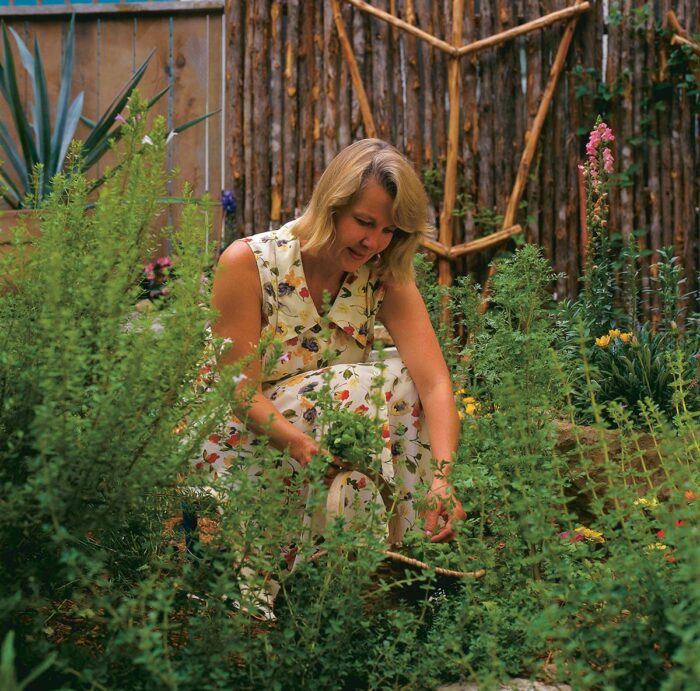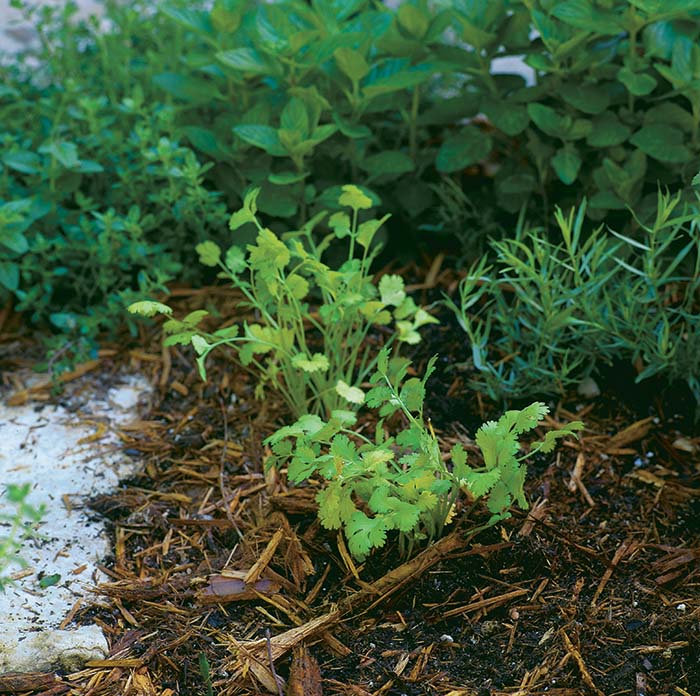How to Grow Cilantro
Cool weather and lots of light are essential when growing this pungent herb

Cilantro shows off its versatility in the kitchen and in the kitchen garden. Also answering to names such as “coriander leaf” or “Chinese parsley,” this aromatic herb is bursting with flavor and bouquet. At once pungent, complex, and redolent of citrus and spice, cilantro provides a refreshing foil for the fiery chiles, garlic, and spices favored in Mexican, Chinese, Southeast Asian, and Indian foods.
Cooks around the world use different parts of this plant. Thai cuisine prizes the roots in spicy marinades, while the bright green leaves season and garnish Chinese stir-fries and Vietnamese noodles. Packed with inimitable personality, cilantro leaves also provide the green garnish that enlivens Mexican salsas, soups, and salads.
Even cilantro’s seeds—known as coriander—have international culinary appeal, and its dainty white flowers may be used as an edible garnish for salads or sorbets.
While cilantro brings delight in the kitchen, it may cause gardeners despair when they attempt to grow it. Cilantro abounds in hot-blooded countries and cuisines, yet it does not abide hot weather and bolts at the first sign of summer (or spring) in my Texas garden. Several unseasonable 80°F days in February will send it into a premature flowering frenzy.
I learned to grow cilantro the hard way. Following the advice in British and New England herbals, I sowed seeds in spring once there was no danger of frost. By April, I had a garden full of stunted cilantro plants in full bloom, long before their culinary partners—tomatoes, chiles, eggplant, and squash—were ready for harvest. In the fall, however, I discovered self-sown volunteers exuberantly springing forth from the earth.
Sow cilantro in fall through winter
Now I sow cilantro seeds in successive plantings every few weeks from early September through February, assuring me a steady supply of tender greens as well as flowers. Sometimes I scatter seeds on a whim; otherwise, I sow seeds ½ in. deep, thinning the seedlings to 12 in. apart. I plant cilantro in several areas of my garden, using it as an edible ornamental in the flower bed as well as a staple in the kitchen garden.
When the plant is young, cilantro’s glossy, finely divided flat leaves resemble those of Italian parsley, then it visibly changes in character. As the plant stretches to reach its ultimate height of 2 ft. to 2½ ft., it appears spindly with small, sparse, and lacy secondary leaves. Throughout its growth, the leaves and stems of cilantro may be used. The newer, greener leaves are preferable to the feathery secondary leaves, which have a tendency to be bitter.
Those with limited garden space may choose to buy cilantro transplants from nurseries. One or two plants per garden should be adequate. Since it has a long taproot, it should not be transplanted once established in the garden. With the exception of its proclivity to bolt, cilantro is a worry-free annual and virtually takes care of itself. Cilantro thrives when given ideal growing conditions—rich, loose, well-drained soil, full sun, and adequate water—but it will grow in some shade. In fact, offering cilantro some afternoon shade can prolong the season slightly. Northern gardeners face their own challenges in growing cilantro; see “How to grow cilantro north of the border” (below) for some tips.

Offer light feedings of fish emulsion and seaweed when first establishing the plants; continued feedings will sacrifice flavor for foliage. Application of compost around the base of the plant adds nutrients, helps retain water, and keeps the roots cool. Cilantro’s odoriferous qualities seem to repel harmful insects, yet butterflies, ladybugs, and other beneficials frequently come to visit.
Cilantro flourishes on cool nights and sunny days, like those found in autumn. Virtually unfazed by brief cold snaps and only slightly rumpled after a hard freeze, it rallies again with renewed vigor and fresh growth at the first hint of sunshine. These plants continue to grace the garden for several months until their grand finale, a wispy profusion of delicate white flowers prior to setting seed.
Slow-bolt seeds seem to extend cilantro’s productivity, sometimes giving an extra month of growth before bolting. Although pinching off the flower heads as they emerge may deter it slightly, once cilantro has set its mind to flower, it will. Up shoots a thick purplish stalk, while the leaves become feathery and fern-like. Cutting the stalk only makes it push harder. To my dismay, I must accept the fact that I cannot have cilantro fresh from my garden in the summertime. Instead, I simply rely on readily available and inexpensive bunches from the supermarket, and eagerly await its reemergence in my fall garden.
Coriander seeds burst with flavor
Cilantro’s shiny seeds resemble small green peppercorns. The clean, strong citrus taste of the unripened seeds is a natural breath freshener. Sprinkle them over salads, poached salmon, or grilled fish for a surprising burst of flavor. The seeds—known as coriander—ripen to a toasty brown, mellowing in flavor. They are renowned for their bittersweet bite in spice blends and baked goods, and I always add them to homemade chicken and beef stock.
Harvest the coriander seeds before they dry out in the hot sun by hanging the long stems of the plant upside down in a paper bag in a dark, well-ventilated room. The seeds will fall off their stems when shaken. They should be stored in an airtight jar to protect them from weevils.
 |
 |
Its propensity to bolt makes cilantro tricky to grow, but oh, what a sight once the warm weather hits! When the plant elongates and feathery foliage appears, flowers and seeds will soon follow. Make the best of bolted cilantro by collecting its seeds. Ground coriander is a prized flavor in many international cuisines.
Cilantro will keep coming back
Once cilantro has made a home for itself in your garden, it willingly reseeds, offering fragrance, flavor, and flowers. The perfumy orange-peel essence of coriander seeds has international appeal. The seeds flavor European pastries and bread, liqueurs, gin, and Middle Eastern coffee. They are an essential ingredient in Indian curry pastes and powders, Southwestern chili powder blends, and pickling spices. And through the centuries, coriander has been renowned as an aphrodisiac. Does anyone need yet another reason to grow this intriguing herb?
Tracing the roots of coriander
Aphrodisiac, carminative, and spice, coriander cures what ails you and puts some zing into your life as well. Hippocrates recommended it, ancient Egyptians used it, and the Bible makes reference to it. During the Middle Ages, coriander was used in medicine, cooking, and love potions. The word coriander sprang from the Greek word koris, which means “bedbug,” referring to the similarity in smell between the insect and the herb. It is fitting that a plant with such earthy etymological roots has found favor throughout the world.
How to grow cilantro north of the border
Cilantro is productive for only about six weeks in cooler climes, so here are some tips for dealing with its persnickety nature.
• Dedicate a small patch of garden to cilantro.
• Direct-sow plants every two to three weeks, starting about two weeks before the last frost date.
• Once the plants bolt, allow them to go to seed. (Cilantro bolts when temperatures climb above 75°F for a few consecutive days.)
• Retain the patch so that self-sown plants will come up in the spring.
• Grow Vietnamese coriander indoors during winter. The flavor is the same.
The word cilantro, which is the one most people associate with the leafy greens of the plant, as opposed to the seeds, probably came from south of the border.
This article originally appeared in Kitchen Gardener #8.
Fine Gardening Recommended Products

Berry & Bird Rabbiting Spade, Trenching Shovel
Fine Gardening receives a commission for items purchased through links on this site, including Amazon Associates and other affiliate advertising programs.

A.M. Leonard Deluxe Soil Knife & Leather Sheath Combo
Fine Gardening receives a commission for items purchased through links on this site, including Amazon Associates and other affiliate advertising programs.

Razor-Back Potato/Refuse Hook
Fine Gardening receives a commission for items purchased through links on this site, including Amazon Associates and other affiliate advertising programs.








Comments
Log in or create an account to post a comment.
Sign up Log in